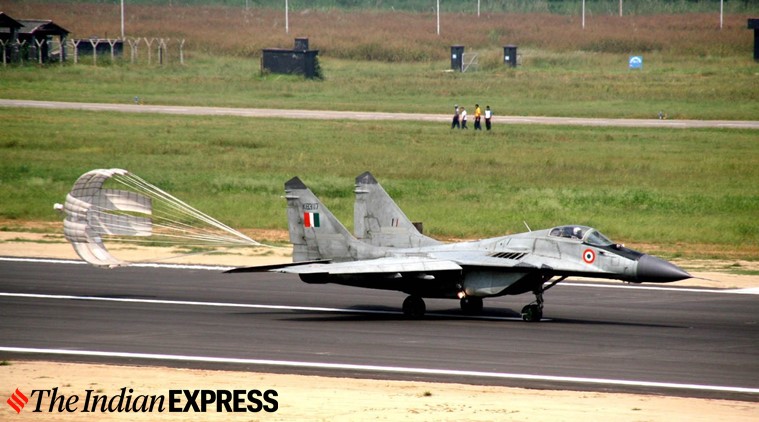 File: A MiG-29 during an air show near Jalandhar. (Express photo: Sarabjit Singh)
File: A MiG-29 during an air show near Jalandhar. (Express photo: Sarabjit Singh)
Days after Defence Minister Rajnath Singh wrapped up a visit to Russia amid the tense standoff between Indian and Chinese troops on the Line of Actual Control (LAC) in Ladakh, the central government Thursday announced the purchase of new fighter aircraft, including 21 MiG-29s and 12 Su-30MKIs, missiles, ammunition as part of a Rs 38,900-crore package to boost the combat capabilities of the armed forces.
Singh, who deferred a visit to Ladakh scheduled Friday, chaired the meeting of the Defence Acquisition Council (DAC) that cleared the package citing “the current situation” and the “need to strengthen” the armed forces “for the defence of our borders and in line with” Prime Minister Narendra Modi’s “clarion call for Atmanirbhar Bharat”.
No reason was cited for the postponement of Singh’s visit to Ladakh nor a new date announced.
Singh was to be accompanied by Army chief General M M Naravane and Northern Army Commander Lt General Y K Joshi. He was to conduct a review of the ground situation and meet Army commanders at the XIV Corps Headquarters in Leh.
The DAC, the government said, “approved the proposal for procurement of 21 MIG-29 along with upgradation of existing 59 MIG-29 aircraft and procurement of 12 Su-30 MKI aircraft. While the MIG 29 procurement and upgradation from Russia is estimated to cost Rs 7,418 crore, the Su-30 MKI will be procured from Hindustan Aeronautics Limited (HAL) at an estimated cost of Rs 10,730 crore”.
“Focused on indigenous design and development, these approvals include acquisitions from Indian industry of Rs 31,130 crore. The equipment is going to be manufactured in India involving Indian defence industry with participation of several MSMEs as prime tier vendors. The indigenous content in some of these projects is up to 80 per cent of the project cost.
“A large number of these projects have been made possible due to Transfer of Technology (ToT) by Defence Research and Development Organisation (DRDO) to the indigenous industry. These include Pinaka ammunitions, BMP armament upgrades and software defined radios for the Indian Army, Long Range Land Attack Cruise Missile Systems and Astra Missiles for the Indian Navy and Indian Air Force (IAF). The cost of these design and development proposals is in the range of Rs 20,400 crore,” an official statement said.
“Acquisition of new/additional missile systems will add to the fire power of three Services. While acquisition of Pinaka missile systems will enable raising additional regiments over and above the ones already inducted, addition of Long Range Land Attack Missile Systems having a firing range of 1,000 kilometres to the existing arsenal will bolster the attack capabilities of the Navy and the Air Force. Similarly, induction of Astra Missiles having Beyond Visual Range capability will serve as a force multiplier and immensely add to the strike capability of the Navy and Air Force,” it stated.
The situation along the LAC in Ladakh remains tense, even after three rounds of discussions at the level of Corps Commanders, the most recent on Tuesday. After the talks at Chushul between XIV Corps Commander Lt General Harinder Singh and South Xinjiang Military Region Commander Major General Liu Lin, both sides “emphasised the need for an expeditious, phased and step-wise de-escalation as a priority”. But India is still waiting for China to take some steps on the ground in this regard.
The move comes against the backdrop of the standoff between Indian and Chinese troops in multiple locations in eastern Ladakh. Tensions had escalated after 20 Indian soldiers were killed during a violent clash in Galwan Valley on June 15. The Indian Army had said there were casualties on both sides. However, Beijing has been silent on PLA losses.
Earlier this week, India banned 59 apps with Chinese links, including TikTok, UC Browser, SHAREit and WeChat, saying they were prejudicial to the sovereignty, integrity and security of the country.